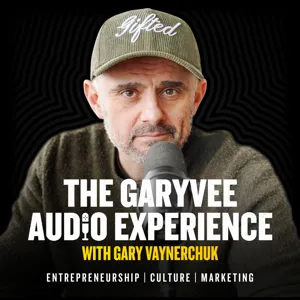Podcast Summary
Owning your channels vs renting them for community building: Investing in organic community-building through ambassador programs can lead to long-term success, while owning your channels instead of relying on rented spaces like social media and paid ads is crucial for sustainable growth.
Building a strong community is essential for businesses to strengthen customer relationships, foster innovation, and gain a competitive advantage. Experts Melody McCluskey from Southseats, Camille from Notion, and Eric Lam from AspireIQ shared their insights on this topic. Eric, who founded a software platform dedicated to fostering brand communities, emphasized the importance of owning your channels instead of renting them, such as social media and paid ads, which can get expensive over time. Building organic referral sources through ambassador programs takes time but is a valuable investment for long-term success. Melody and Camille also highlighted the importance of community-building in their respective businesses, which have led to significant revenue growth and loyal followings. In today's climate, where building and maintaining a strong community is more important than ever, these experts provided valuable insights into the strategies and benefits of community-building for businesses.
Transforming a free platform into a paid service through community building: Creating value for both sides of a two-sided platform and building a community through events and resources can lead to significant growth and profitability.
Building an advocate network organically through social media and creating value for both sides of a two-sided platform can lead to significant growth. Melody from Styleseat shared her experience of transforming a free platform into a paid service, which initially seemed scary but ultimately led to profitability and the ability to support their community of beauty professionals and high-end clients more effectively. Community building through events and becoming a valuable resource for consumers were also crucial factors in their success. The renting versus owning channel approach was also emphasized as a key strategy for businesses looking to build their own communities.
Transitioning from free to paid model leads to business success: A free model can lose some customers but lead to a successful business through increased conversions and revenue, allowing for product improvements and community building
Charging for a product or service can lead to a successful business, even if it results in a loss of some customers. This was the experience of a company that made the transition from a free model to a paid one, which resulted in a 20% conversion rate. However, the professionals who had engaged with the product seriously were more likely to convert. This revenue allowed the company to build out product features and make the product more valuable, leading to profitability in the first month. Creating branded communities can also help fuel a business, as seen with Notion, whose fans have formed a strong community through sharing and educating others. Notion's success was a result of both intentional efforts and the product's inherent appeal. Empowering community members to build their own businesses and monetize their efforts has led to a successful and expanding community.
Community design alongside product design: Engaging the community from the start leads to organic growth, authentic engagement, valuable feedback, and an enhanced brand experience.
Successful product development, especially for social or collaborative products, involves both product design and community design. Product design focuses on selecting features, while community design curates the right people to join the community and fosters organic feedback. This approach, as seen with companies like Notion, Slack, and Glossier, can lead to organic growth and authentic engagement. For instance, Glossier started engaging with their community from day one, inviting women to try their products and creating a tightly-knit group. This community engagement not only provides valuable feedback but also enhances the brand experience and customer journey. While some may argue that building a great product is enough, actively involving the community from the start can lead to even more significant growth and success.
Identifying and engaging with passionate users: Start small, use familiar tools, and engage with passionate customers to build a successful community around a business in the beauty industry.
Focusing on product-market fit and starting small are key strategies for building a successful community around a business, especially in the beauty industry where there's vast untapped potential. StyleSeat, a platform for beauty professionals, achieved this by identifying and engaging with their most vocal and engaged users through familiar tools like Slack. Starting with small, simple steps and using tools that people are already using can help build a community organically. Additionally, having a great product that customers love and advocating for is essential. Begin by identifying and engaging with small, passionate customer bases on social media and creating incentives for them to engage with the brand or each other. This approach can lead to organic growth and a strong community that can help augment your platform and bring in new clients.
Identifying and nurturing relationships with passionate customers: Start small, invest time in building relationships, and look for patterns of engagement to identify and invest in superfans. Surprise and delight moments can help deepen relationships with enthusiastic customers.
Building a brand ambassador program starts with identifying and nurturing relationships with passionate customers. This can be done informally in the early stages, by engaging with customers who naturally talk about the brand and offering them incentives or experiences. The difference between a satisfied customer and a superfan can be identified by their level of engagement and enthusiasm. This process is manual and time-consuming, but the cost is more in time than money. As relationships deepen, brands can formalize them through contracts or advertising in engaged communities. The key is to start small, invest time in building relationships, and look for patterns of engagement to identify and invest in superfans. Surprise and delight moments can also help identify and deepen relationships with enthusiastic customers.
Creating an authentic community: Focus on community topics, provide resources, be radically transparent, allow peer-to-peer interaction, understand goals, and create tools to help achieve them.
Building an authentic community involves making it about them and creating a peer-to-peer environment. This can be achieved by focusing on topics that are important to the community, providing resources and insights, and being radically transparent. Events and opportunities for community members to interface with each other without oversight have also been successful. Understanding their goals and creating tools and resources to help them achieve those goals is another effective strategy. Being transparent, even during mistakes, can help shield the community from potential backlash. An authentic community feels invested in all aspects of the project, including the mistakes. A great example of this is Fig Scrubs, which has built a lot of its growth through social media movements and content driven campaigns centered around the personal stories and experiences of healthcare professionals.
Engaging with community members for business success: Building a strong community can lead to increased loyalty, engagement, and growth for businesses by understanding and responding to member needs, staying authentic, and managing potential risks.
Building and managing a community can be incredibly beneficial for businesses, particularly those in the creator-driven space or marketplaces/platforms. Engagement and understanding the needs and desires of the community members. Brands often take a more endorsement role rather than active leadership, allowing communities to remain organic and authentic. However, potential risks such as negative feedback or backlash should be considered and managed carefully. Companies like FIGS have seen success by staying close to their community, actively engaging with members, and responding to their feedback. While community building is generally applicable to various types of businesses, it may be less critical for commodity-driven marketplaces. Ultimately, building a strong community can lead to increased loyalty, engagement, and growth for businesses.
Authenticity in business and standing for something: Being clear about your stance on social justice issues allows customers and employees to make informed decisions, even if it means losing some customers or opportunities.
As a business or brand, deciding what you stand for and being authentic about it is crucial. This requires thoughtful and deliberate introspection, as there will be unexpected events that demand a response. In the beauty industry, where social justice and racial justice issues are particularly relevant, it's essential to acknowledge the connection between your business and these topics. Founders must consider their personal views and how they want their company to engage with these issues. This could range from staying neutral to actively advocating for certain causes. Ultimately, being clear about your stance allows customers and employees to make informed decisions about whether they align with your values. Even if it means losing some customers or opportunities, authenticity is key to building a loyal community.
Strategic gifting and influencer outreach for community building: Understand target audience, be transparent, reach out to influencers, build diverse and inclusive community, manage growth with community help
Starting a community around a product can be facilitated through strategic gifting and outreach to influencers. The speaker emphasizes the importance of understanding the target audience, being transparent about the brand, and reaching out to influencers with large followings. These influencers can help spread the word about the product, especially for startups that may not have the budget to pay for their endorsement. The speaker also mentions the importance of building a diverse and inclusive community from the ground up, and growing it through invitations. However, as the community grows, managing it becomes a challenge. The speaker shares an example of Clubhouse, a community built on invites, and how they enlisted the help of the community to invite a diverse group of people. Overall, the discussion highlights the importance of community building in growing a product, and the role strategic gifting and influencer outreach can play in that process.
Building a diverse global community on Clubhouse: Effective community management and real-time user feedback are crucial for building a successful global network on Clubhouse.
Building a global network of diverse communities using a live audio app like Clubhouse is a complex and ever-evolving process. It requires effective community management and the ability to gather real-time feedback from users to quickly iterate and improve the product. The unique feature of live group audio allows for constant communication between users and the development team, creating a valuable focus group for product development. While some may argue that companies should take a stance on social issues, Paul argues that it can be a challenging and potentially divisive issue for large companies, and that focusing on building the company and ensuring a diverse community is the best way to ensure success.
Taking a public stance on social issues: Powerful for community building and business growth: Company leaders should engage in uncomfortable conversations, embrace underrepresented voices, and actively listen to diverse perspectives to build a strong community and grow a business through taking a public stance on social issues.
Building a community and taking a public stance on social issues as a company can be a challenging decision. Melody's perspective is that it's her company and she can make her own values clear, regardless of whether people use her product or work for her. However, as a company grows, it becomes harder to maintain a neutral stance, especially when the company is intertwined with a specific community. From a practical standpoint, taking a stance can be beneficial for business growth and inclusivity. However, it's essential for company leaders to be present and engaged in the community they serve, even if it means entering uncomfortable conversations. Chauncey emphasized the importance of embracing and supporting underrepresented voices in the community, especially during times of crisis. In conclusion, taking a public stance on social issues can be a powerful tool for building a strong community and growing a business, but it requires active engagement and a willingness to listen and learn from diverse perspectives.
Feeling of disconnect and lack of representation for some black users: Online communities need ongoing dialogue and action to address issues of representation and inclusion.
There is a feeling of disconnect and lack of representation among some members of the community, specifically black users, on a particular platform. Chauncey Bell expressed this sentiment, sharing his experience of not feeling included or loved within the community despite enjoying it and contributing to it. Rohan, in response, acknowledged the concerns and shared his perspective of the platform's early response to social justice issues, emphasizing the support and dialogue that took place behind the scenes. Rohan also encouraged diversity and inclusivity, inviting users of all backgrounds to join and engage in the community. It's important to note that these conversations highlight the need for ongoing dialogue and action to address issues of representation and inclusion in online communities.
Challenges of building a community for a confidential product: Creating a supportive community for a confidential product requires careful consideration. Potential solutions include a closed, invite-only community or sharing success stories without revealing specifics.
Building a supportive and organic community around a product or service can be challenging when users value the confidentiality of their use and don't want to reveal they're using it to their competitors. This was discussed during a conversation about managing a community for a platform that connects fashion brands and designers to Italian manufacturers. The users' reluctance to share their experiences and be ambassadors was due to the fear of competitors discovering their partnership. While this is a compliment to the product's value, it makes it difficult to grow the community and create more activity on the platform. One potential solution suggested was to create a closed, invite-only community where users can share their opinions and experiences in a less public and less scrutinized way. Another idea was to encourage users to share their success stories in a way that generates curiosity without directly revealing their use of the platform. These suggestions may not fully solve the issue, but they provide potential avenues for nurturing a community while respecting the users' need for confidentiality.
The value of collaboration and mutual learning: Active participation and engagement in learning are essential for growth and development, and collaboration provides mutual benefits through sharing knowledge and experiences.
Importance of active participation and engagement in learning. The speakers expressed their gratitude towards the audience's involvement and emphasized that they learn just as much from these conversations. They also expressed their appreciation for being invited to speak and for the opportunity to engage with the audience. Overall, this dialogue highlights the value of collaboration and the mutual benefits of sharing knowledge and experiences. It serves as a reminder that learning is a two-way street, and active engagement is essential for growth and development.






